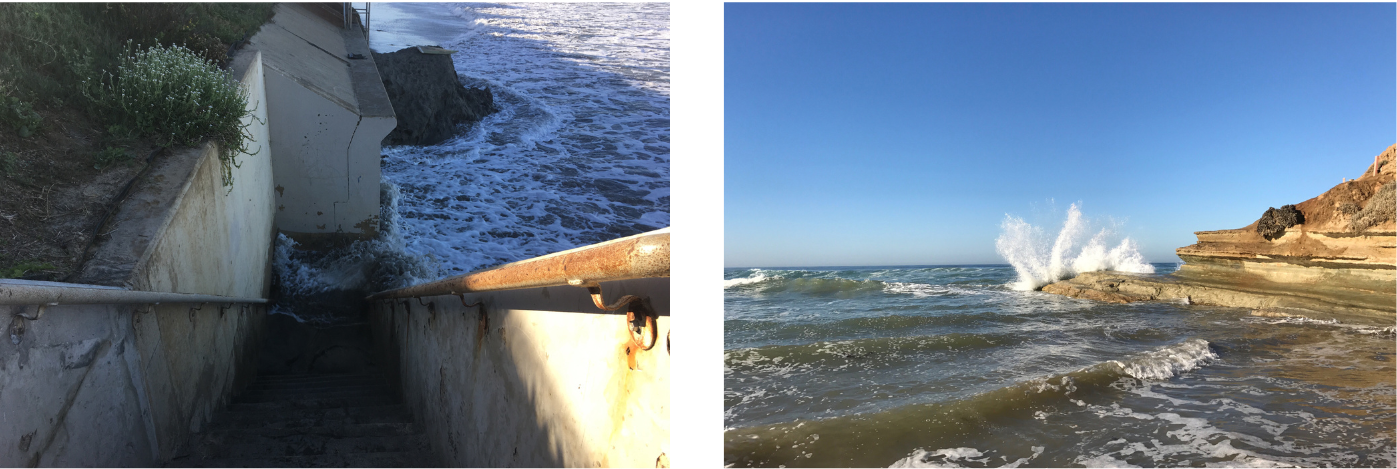Communicating for Coastal Resilience
For as long as I can remember, I’ve been fascinated by the ocean and the marine biome. At the surface, the deep blue water glistens as the sunlight reflects off of it while taking a look below further demonstrates the beauty of our natural world. However, my long-held fear of how deep the ocean really goes has prevented me from ever venturing in. So, I settled for the coasts, and being an avid visitor to California throughout my life, I got to appreciate the natural beauty of the land bordering the Pacific. Standing on the beaches, feeling the ocean breeze, and smelling the salty air, I could see why millions of people continuously flocked to the coasts whatever time of the year it was. Now, imagine that you, the reader, are standing on a California beach of your choosing and are taking in all there is to. Take a moment to close your eyes and mentally transport yourself there (try to smell the salty air). Stay there for a moment; then, press pause on that visual and zoom out from the beach you’re standing on.
Keep zooming out until you can see the map of the contiguous United States (you’ll understand why this is necessary shortly). Shift yourself over to Nevada and head south to the desert of the Las Vegas Valley (summer here is much worse than an LA summer, FYI). If you zoom into the Valley, somewhere in the suburbs is where you’ll find me, sitting at my laptop and working at my internship this summer.
Now that you’ve somewhat located me, let’s do a quick introduction. My name is Abeerah Siddiqui and I’m a rising senior studying environmental science and health at USC. This summer, I had the privilege of working with my mentor Karina Alvarez, a Science, Research, and Policy Specialist at USC Sea Grant along with others in a joint coastal management research team consisting of Phyllis Grifman, Dr. Charles Lester, Dr. Juliette Hart, Ashley Cooper, and Andrew Davidov. My internship was a part of the Wrigley Institute’s Environmental Communications Internship program and I was tasked with assisting the team with their ongoing project (more about that in a bit).

Science communications has become a rapidly growing field in recent years and understandably so. With all the research happening around us, scientists and scholars need to be able to explain their work in more general terms so that anyone can understand the significance of their work. As someone with a science background, but also an interest in more creative fields (writing, graphic design, etc.), science communications is a field that perfectly blends these interests of mine. When I was a child, I never could have imagined such a field and explored these interests separately—unless you count the hours of Planet Earth I immersed myself in. So as soon as I saw the opportunity to gain experience with it in the context of the environment, I immediately applied!
This summer, I was part of a project focused on California coastal management and adaptation. As you may already know, one of the major consequences of climate change has been sea level rise, and in California, this has led to beaches disappearing and coastal communities becoming increasingly susceptible to related damages. To gain a better understanding of how prepared communities felt, the research team distributed a survey throughout California in the first half of 2023. Next came the difficult part: sorting through hundreds of responses and effectively visualizing the data. It was at this point in the work that I joined in! The majority of my time was spent on organizing the data in the survey section specifically addressing coastal management and climate change. This section primarily focused on assessing respondents’ current level of knowledge on the topic and their level of preparation to face present threats to the coasts.
Another smaller project I assisted my mentor with was planning the June AdaptLA webinar. These webinars aim to advance sea level rise and coastal impacts planning in Southern California and often feature speakers experienced in different aspects of coastal science. In this session, we got to hear from Karina Johnston, a current PhD student at UCSB, and her work on beach restoration. She, along with her team, was able to successfully restore native vegetation on a portion of Santa Monica Beach! You may be wondering how this relates to coastal management (don’t worry, I did too initially), but restoring this vegetation helps restore the natural dune barriers that prevent the tides from coming too far inland. To make it simple, our beaches won’t disappear! Anyone can join the webinars and you can watch the most recent one here.

I have learned a great deal about coastal policy and management over the past ten weeks. From having absolutely no exposure to coastal science, I have now enrolled in a coastal policy class for the upcoming semester. This internship further highlighted to me the significance of our coasts, wherever they are, and how integral they are for the persistence of coastal communities. I also learned about common adaptation strategies like beach nourishment and how they can protect our coasts against rising sea levels. I’m not sure that I can pinpoint one aspect that I enjoyed the most but it was a pleasure working with everyone and learning something new from each of them. I hope to continue learning about coastal management and adaptation, and will also continue exploring the world of science communications and see what else it has to offer.
Thank you to everyone at Wrigley, my fellow interns, and the research team for enlightening me all summer and for giving me the opportunity to engage with the environment through a new lens.
